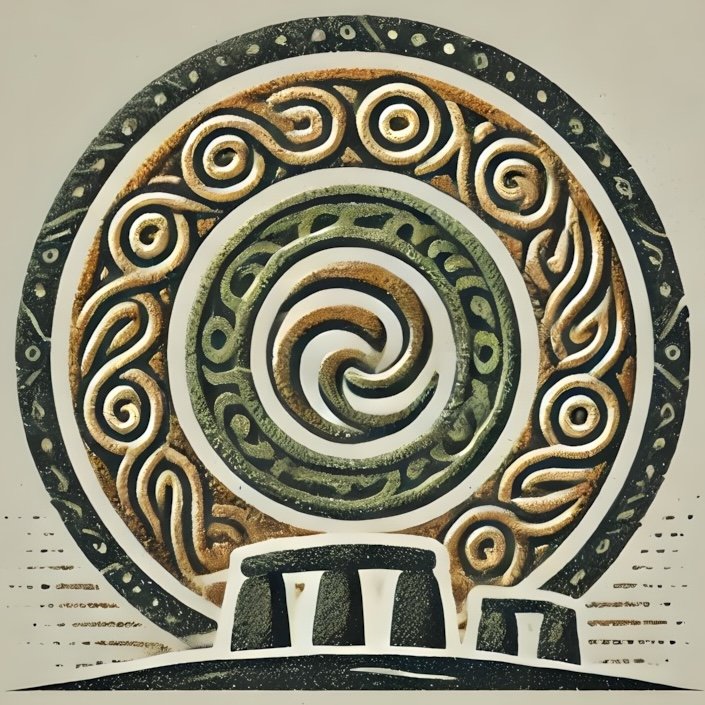Archaeological and Historical Evidence: The Dagda’s Harp and the Heroic Cycles
Irish prehistory is a tapestry woven with threads of myth, legend, and tangible archaeological evidence. As we delve into the connections between the mythical narratives of the Irish landscape and the remnants of its ancient past, we find ourselves at the intersection of the extraordinary and the historical. This exploration not only illuminates the rich cultural heritage of Ireland but also invites us to visit the sites where these stories unfolded. In this section, we will examine the archaeological evidence of hillforts, the discovery of musical instruments, and other significant elements that bridge the gap between myth and history.
Hillforts and Their Connections to Mythological Narratives
Hillforts, or dún, dot the Irish landscape, standing as monumental testaments to the social and political structures of ancient communities. These fortified settlements, often perched on elevated ground, served as both defensive structures and symbols of power. They are not merely relics of the past; they are integral to the mythological narratives that have shaped Ireland’s cultural identity.
One of the most notable hillforts is the ancient site of Emain Macha, located in County Armagh. This site is steeped in myth, being closely associated with the legendary Ulster Cycle, particularly the tales of the hero Cú Chulainn. Emain Macha is described in the Táin Bó Cúailnge (The Cattle Raid of Cooley) as the royal seat of the kings of Ulster. The fort’s strategic location and its imposing structure echo the power dynamics depicted in the myths. The tales of battles, heroism, and supernatural events that transpired here resonate with the very stones of the fort, inviting visitors to imagine the epic narratives that unfolded within its walls.
Another significant hillfort is Dún Aonghasa on the Aran Islands, which offers a breathtaking view of the Atlantic Ocean. This site is often linked to the mythological figure of Aonghus, the god of love and youth, who is said to have had a stronghold here. The fort’s circular walls and the dramatic cliffs that surround it evoke a sense of the divine, connecting the physical landscape with the celestial narratives of the gods. The interplay between these hillforts and their corresponding myths reveals how the ancient Irish people understood their world, intertwining the sacred with the everyday.
Evidence of Musical Instruments in Archaeological Finds
Music has always played a pivotal role in human culture, and Ireland is no exception. The archaeological evidence of musical instruments not only highlights the artistic expression of ancient peoples but also connects to the mythological narratives that celebrate music as a divine gift. One of the most famous figures associated with music in Irish mythology is the Dagda, a prominent god of the Tuatha Dé Danann, who is often depicted with a magical harp that could summon the seasons and influence emotions.
Archaeological finds, such as the discovery of ancient bone flutes and lyres, provide tangible links to the musical traditions of prehistoric Ireland. The bone flute unearthed at the site of Lough Gur in County Limerick, dating back to the Neolithic period, is one such artifact. This flute, crafted from the bone of a swan, suggests that music was an integral part of social and ceremonial life, echoing the tales of the Dagda’s harp that enchanted all who heard it.
The Tara Brooch, another remarkable artifact, showcases the intricate artistry of early medieval Ireland. While primarily a piece of jewelry, its design reflects the cultural significance of music and performance in Irish society. The brooch is often associated with the legendary Hill of Tara, a site deeply embedded in the mythology of the Irish kings. The connection between such artifacts and the stories of the past reinforces the idea that music was not merely entertainment but a vital component of identity and spirituality.
The Role of Ritual and Ceremony
In addition to hillforts and musical instruments, the archaeological record reveals the importance of ritual and ceremony in ancient Irish society. Sites such as Newgrange and Knowth, part of the Brú na Bóinne UNESCO World Heritage Site, demonstrate the sophisticated understanding of astronomy and the cyclical nature of life that the ancient Irish possessed. These passage tombs, aligned with the winter solstice, served as places of burial and ritual, connecting the living with their ancestors and the divine.
The myths surrounding these sites often speak of the Otherworld, a realm where time is fluid, and the boundaries between the living and the dead blur. The tales of the Tuatha Dé Danann, who are said to have arrived in Ireland from the Otherworld, highlight the significance of these burial sites as gateways to the mystical. The alignment of the tombs with celestial events suggests that the ancient Irish viewed their world through a lens that intertwined the physical and the spiritual, a theme echoed in the stories of the heroic cycles.
The Dagda’s Harp: A Symbol of Power and Influence
The Dagda’s harp, known as Uaithne, is not just a musical instrument; it is a potent symbol of authority and influence within the mythological landscape of Ireland. According to legend, the harp had the power to control the emotions of those who heard it, capable of bringing joy or sorrow at the Dagda’s command. This connection between music and emotion underscores the belief that art could shape reality, a concept that resonates with the archaeological evidence of musical practices in ancient Ireland.
The harp also serves as a metaphor for the interconnectedness of the natural and supernatural worlds. Just as the Dagda’s harp could summon the seasons, the archaeological record reveals how music and ritual were used to mark the passage of time and the cycles of nature. The reverberations of the past can still be felt today, as modern musicians draw inspiration from these ancient traditions, keeping the spirit of the Dagda alive in contemporary Irish culture.
The Interplay of Myth and Archaeology
As we explore the archaeological and historical evidence of Ireland’s prehistory, we begin to see the intricate dance between myth and reality. Hillforts, musical instruments, and ritual sites serve as physical manifestations of the stories that have shaped the Irish identity. The tales of the Dagda, Cú Chulainn, and the Otherworld are not merely flights of fancy; they are grounded in the landscapes and artifacts that tell the story of a people deeply connected to their history and mythology.
Visiting these sites allows us to walk in the footsteps of our ancestors, to feel the weight of their stories, and to understand the profound impact of their beliefs on the world we inhabit today. The echoes of the past resonate through the hills, the music, and the rituals, inviting us to engage with the rich tapestry of Irish prehistory and mythology.
Meta – Examine the archaeological and historical evidence linking the Dagda’s Harp to Ireland’s heroic cycles, enriching your understanding of Irish prehistory.

